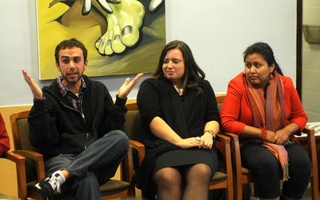It’s hard to be mad at Teach for America (TFA). The program has done so much over the past 15 years to draw attention to the inexcusable inequalities that exist in our public schools. It’s led so many of the brightest students in the nation to seriously consider teaching as a post-college option—eight percent of us here at the College applied last year, and numbers will probably continue to rise.
Yet, for a program bringing top minds into the education world, TFA is sending some very dangerous messages about the teaching profession. While many of its alums stay in education, it nonetheless implies that teaching, while a demanding occupation, can be merely a two-year prelude to one of those “real” professions like law or medicine that require years of training. Essentially, the program makes the argument that smart people are ready to teach a full load of classes in some of the nation’s toughest schools after only five to six weeks of summer training.
Unsurprisingly, the evidence suggests that better training for corps members would benefit both teachers and students. A strong majority of TFA teachers manage to make it through their two years in the classroom, but just about everyone has heard horror stories about that friend or friend of a friend who didn’t make it to summer vacation. And poor training ultimately ends up under-serving the students who we are trying to help. Recent research out of Stanford has found that students taught by corps members do not, on average, perform as well as students taught by fully-trained, certified teachers.
Thus, while TFA is very good at portraying itself as “the elite” program for entering teaching, I would argue that there are far superior programs out there if you really want to be an elite teacher. There are several types of training programs that—while perhaps not as highly publicized as TFA—bring a distinct set of advantages for entering the teaching profession and set you up to give your students much better experiences in the classroom.
The first type of training program worth considering is a local teaching fellowship. Such programs—in cities such as NYC, DC, Miami, and Philly—give you two distinct benefits over TFA. First, they give you the guarantee of geographic choice. If you get into these programs, you can basically know where you will be teaching next year—TFA cannot guarantee that you will get your first or even second choice of regional location. Secondly, because they are locally based, these programs tend to offer summer training that is much more specific and related to the actual curriculum that you will begin teaching in the fall.
But if you really want to get the best type of training, I encourage you to check out one of the more intensive teacher residency programs like the New Teachers Collaborative. These programs not only give you good upfront teacher training, but they also set you up with dedicated mentor teachers (which a couple of the local fellowships are starting to do as well). Most importantly, however, they don’t give you a full class load for your first year so that you have the time and energy to reflect and learn from your teaching experience. As any teacher will tell you, such an environment is essential. There is a limit to how much you can prepare before you first set foot in the classroom—most of your learning can only come by doing. These residency programs give you the opportunity to learn from your mistakes rather than burnout. And the good news is that Harvard is seriously considering launching its own state-of-the-art fifth-year program in the near future that would not only offer a generous stipend but a Masters in Education as well!
A common quip heard in education schools nowadays is that if we really wanted to “teach for America,” we’d ship the greenhorn college grads back to teach in the rich, suburban schools from which so many originate and send the well-trained suburban teachers off to poorer, urban schools where the students might most benefit from them. Such a strategy is probably impossible, but it underscores a question about TFA that we can’t ignore: why are we sending our least-prepared teachers off to teach at some of the nation’s highest-need schools?
It’s good that programs like TFA exist to send smart, driven people into schools which probably would not get them otherwise. And if TFA gave more training, it probably would need to ask for more than a two-year obligation, which would potentially keep many people from trying teaching and make the program more costly.
So, in the spirit of 2Pac: “TFA, I Ain’t Mad at Cha.” But if we truly care about “teaching for America,” we should really consider making a three-to-four-year commitment and getting solid training consistent with the demands of the teaching profession. In the end, doing so will not only benefit us in the classroom but will also give our students the learning opportunities that they truly deserve.
Henry Seton ’06 is a social studies concentrator in Adams House. His column appears on alternate Thursdays.
Read more in Opinion
Have Pro-Choicers Aborted Ship?Recommended Articles
-
Waiting in Line to Stand and DeliverGentry High School in Indianola, Miss. is not a safety school for Eleanor G. Brennan ’02-’03. If she’s lucky, she’ll
-
Teach For America Does Not Need New RecruitsTo the editors: At first glance, it seems that the numbers David M. DeBartolo ’03 cites in his recent op-ed
-
Jonathan KozolThinking back to his undergraduate years, Jonathan Kozol ’58 said he could not remember a single Harvard senior who planned
-
Educating the EducatorsThe launch of the HTF program is a hopeful step, evidence that Harvard is thinking hard about how to provide infrastructure for career paths other than those Harvard has traditionally thrown support behind.
-
 How to Teach Teachers
How to Teach Teachers













